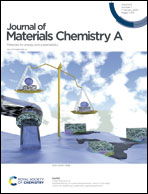A vanadium–nickel oxynitride layer for enhanced electrocatalytic nitrogen fixation in neutral media†
Abstract
The application of transition-metal oxides (TMOs) in electrocatalytic nitrogen fixation still is hindered by their sluggish reaction kinetics and weak stabilization. In this work, a vanadium–nickel oxynitride (VNiON) layer is designed and synthesized on the corresponding oxide nanosheets to solve the above crucial issues. The first-principles kinetics analyses theoretically prove that the delocalized electron environment of VNiON enhanced π backdonation, which is conducive to nitrogen absorption and activation. Experimentally, both the ammonia production rate (∼6.78 μg h−1 cmcat.−2) and faradaic efficiency (∼5.57%) of VNiON are enhanced by 2-fold relative to those of its corresponding oxide under neutral conditions. Meanwhile, the stability of oxide is enormously improved by introducing a VNiON layer. The mechanism of improving the nitrogen fixation performance of oxides is investigated. This work provides a novel strategy of constructing oxides with advantageous structures for extensive electrochemical applications.



 Please wait while we load your content...
Please wait while we load your content...